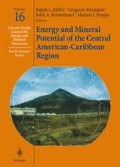Abstract
The Central American-Caribbean region hosts a number of identified nickel resources in nickeliferous latentes. These have been mined in Guatemala, Cuba, Dominican Republic, and Colombia, and currently provide about 12 percent of the world’s annual nickel production.
All the active nickel projects, and most of the known lateritic deposits and potential resources, are on margins of the Caribbean Plate, where slabs of mantle-derived ultramafics have been emplaced above or within crustal rocks. Tropical weathering of the peridotites has created enriched nickel zones within the lateritic weathering profile. Unexploited nickeliferous laterite resources occur in this setting in a number of areas. Nickel sulfide prospects are sparse in the region.
Within the Antilles, Andes, and Central America, very modest possibilities exist for discovery of additional ultramafics and associated nickeliferous laterites. Review of nickel deposit types worldwide indicates that nickel sulfides could occur in some geological environments within the region, and that sulfide deposits have economic advantages over laterites. In the Guiana Shield a reasonable potential exists for discovery of nickeliferous sulfides in Proterozoic greenstone belts.
Many factors affect the potential for future new sources of nickel, including the region’s proximity to ocean transport and markets, abundant water, and benign climate. Offsetting factors in many countries include scarcity of indigenous fuel, limited infrastructure, and variable foreign investment climates. The most promising potential for new nickel projects in the region is for asyet undiscovered sulfide deposits in the Guiana Shield.
Access this chapter
Tax calculation will be finalised at checkout
Purchases are for personal use only
Preview
Unable to display preview. Download preview PDF.
References
Bellizzia G., A., 1967, Rocas ultrabasicas en el sistema montanoso del Caribe y yacimientos minerales, asociados: Caracas, Boletín de Geologia, v. 8, no. 16, p. 159–198.
Bonis, S., O. Bohnenberger, and G. Dengo, compilers, 1970, Mapa geológica de la Republica de Guatemala, escala 1:100,000: Guatemala, Instituto Geografico Nacional.
Case, J. E., and G. Dengo, 1982, The Caribbean region, in A. R. Palmer, ed., Perspectives in regional geological synthesis: Geological Society of America, Decade of North American Geology Special Publication 1, p.163–170.
Choudhuri, A., 1973, Basic magmatism in relation to metamorphism andorogeny in northern Guyana: London, Geological Magazine, v. 110,p. 365–371.
Consejo de Redaccion del Atlas de Cuba, 1978, Atlas de Cuba: Havana, Listituto Cubano de Geodesia y Cartografia, 168 p.
Cox, D. P., and D. A. Singer, eds., 1986, Mineral deposit models: U.S. Geological Survey Bulletin 1693, 379 p.
Del Guidice, D., and G. Recchi, 1969, Geologia del area del proyecto minero del Azuero, mapa 5 (1:250,000): Panama, Instituto Geografico Nacional.
Dengo, G., 1962, Estudio geológico de la region de Guanacaste, Costa Rica: San Jose, Instituto Geografico de Costa Rica, 73 p.
Eckstrand,O. R., 1984, Canadian mineral deposit types-A geologic synopsis: Geological Survey of Canada, Economic Geology Report 36, 86p.
Evans, D. J. I., R. S. Shoemaker, and H. Veltman, eds., 1979, International laterite symposium: New York, Society ofMining Engineers, 688 p.
Gonzales I. H., 1972, Posibles aplicaciones industriales de la serpentinita en Colombia: Bogota, Boletín Geológico, v. 20, no. 3, p. 45–58.
Haldeman, E. G., R. Buchan, J. H. Blowes, and T. Chandler, 1982, Geology of lateritic nickel deposits,Dominican Republic: Society of Economic Geologists Fall Field Trip Guidebook, Economic geology of central Dominican Republic, October, 1972, p. 1639.
Heidenreich, W. L., and B. M. Reynolds, 1959, Nickel-cobalt-ironbearing deposits in Puerto Rico: U.S. Bureau of Mines Report of Investigations 5532, 68p.
Instituto Geografico Nacional Tommy Guardia, 1974, Mapa geológico de Panama, escala 1:1,000,000: Panama, Dirección General de Recursos Minerales.
Kilpatrick, B. E., 1969, Nickel, chromium and cobalt in tropical soils over serpentinites, northwest district, Guyana: Colorado School of Mines Quarterly, v. 64, part 1, p. 323–332.
Marval R. H., 1972, Estudio sobre la meteorización de laperidotita de Tinaquillo, Estado Cojedes: Caracas, Boletín de Geología, Publicación Especial no. 5, Memoria cuarto congresogeológico Venezolano, v. 4, p. 2243–2244.
MacDonald, J. R., 1968, A guide to mineral exploration in Guyana: Guyana Geological Survey and Mines Department Bulletin 38, 91 p.
McBirney, A.R., and M. N. Bass,1969, Geology of the Bay Islands, Honduras, in Tectonic setting of northern Central America and the westem Caribbean: American Association of Petroleum Geologists Memoir 11, p. 229–293.
Petersen, E. U., and H. Zantop,1980,The Oxec deposit, Guatemala; An ophiolite copper occurrence: Economic Geology, v. 75, no. 7,p.1053–1065.
Rodriguez M., S. E., 1986, Recursos minerales de Venezuela: Caracas, Boletín de Geologia, v. 15, no. 27.
Valiance, G., 1970, Investigationof anickeliferous “laterite” in the Kauramembu Mountains (Wanamu-Blue Mountains area), Barama River, North West District, Guyana: Contribution 14, in Proceedings of eighth Guiana geological conference: Georgetown, Department of Mines and Geology.
Wokittel, R., 1960, Recursos minerales de Colombia; Niguel y cobalto: Servicio Geológico Nacional, v. 10, p. 155–156.
Author information
Authors and Affiliations
Editor information
Editors and Affiliations
Rights and permissions
Copyright information
© 1995 Circum-Pacific Council for Energy and Mineral Resources
About this chapter
Cite this chapter
Barnard, F., Prado, F. (1995). Nickel Potential of the Caribbean Plate and Adjacent Regions. In: Miller, R.L., Escalante, G., Reinemund, J.A., Bergin, M.J. (eds) Energy and Mineral Potential of the Central American-Caribbean Region. Circum-Pacific Council for Energy and Mineral Resources Earth Science Series, vol 16. Springer, Berlin, Heidelberg. https://doi.org/10.1007/978-3-642-79476-6_41
Download citation
DOI: https://doi.org/10.1007/978-3-642-79476-6_41
Publisher Name: Springer, Berlin, Heidelberg
Print ISBN: 978-3-642-79478-0
Online ISBN: 978-3-642-79476-6
eBook Packages: Springer Book Archive

